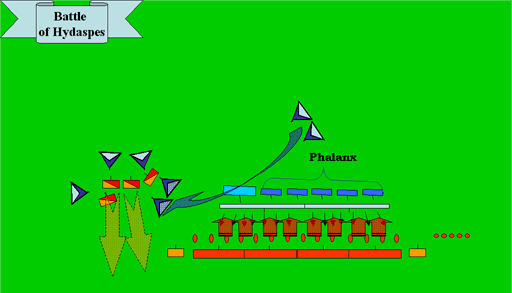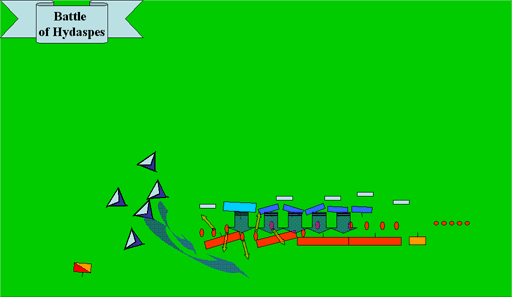- Articles Index
- Monthly Features
- General History Articles
- Ancient Near East
- Classical Europe and Mediterranean
- East Asia
- Steppes & Central Asia
- South and SE Asia
- Medieval Europe
- Medieval Iran & Islamic Middle East
- African History (-1750)
- Pre-Columbian Americas
- Early Modern Era
- 19'th Century (1789-1914)
- 20'th Century
- 21'st Century
- Total Quiz Archive
- Access Account
The Battle of Hydaspes
By Maciek
The last major battle In Alexander's campaign was particular unusual due to use of the elephants by Porus's army in the battle. Never before had Alexander fought against those animals. Knowing the Roman's experiences 50 years later we could assume that it had to be a great and potentially tragic surprise for Alexander. But in this battle Alexander showed once more that he was no ordinary commander. On the contrary to Romans who had to fight three battles to gain enough experience in combat against an enemy with elephants, Alexander using the reconnaissance and intelligence, planned the battle in perfect way which gave him another brilliant victory. This time, however, the terrain was advantageous for enemy, and Alexander had against him good and wise commander - Porus, who had Elephants trained to fight and superiority in number (as always). The Indian king secured the river bank by placing elephants, which made it impossible for the Macedonian army to cross. The situation was very similar to the first stage in Diadoch's wars a few years when the river Nile was impossible to cross because of elephants. Alexander divided his army into two parts. One part, commanded by Crateros, was sent to the north from the camp on his river bank. Crateros ordered his soldiers to fake their number by making as much camp fires as Alexander's entire army would make. Crateros maintained his army to be ready to attack upon order. Alexander, with his part of army (five hipparhies of cavalry, five battalions of phalanx with added hypaspists and also two battalions of mixed bowman and javeliners) crossed the river Hydaspes in a very hard conditions involving heavy rain and deep water. But after that, they placed the Indians in a very difficult situation because Porus now had to decide which option to choose (It is illustrated very well in Fuller's "Generaship of Alexander the Great" peage 189). Porus secured the shore that Crateros was ready to cross and with the rest of his army he stood against the part of Alexander's army which was on his side of the river. The battle itself is a brilliant show of cavalry maneuvers that became decisive factor in this battle. Until now Alexander has made very fast attacks aimed to disorganize enemy lines. He never used the schemes twice and that is why he surprised every enemy. Before the battle of Hydapes, Alexander read books that contained information on elephant warfare, such as how they can be put into a panic when approached by many horses. Thus, his plan was to drive Porus' cavalry from their formation.
I Alexander sent one companion unit on the far left behind his infantry so that Indians would not see them. Another was sent in direction of the forces left to guard the shore. Half of the other cavalry advanced and stopped at the save distance from the enemy and waited. Alexander's infantry units advanced along with the cavalry, but with missile units placed in front of the melee infantry. He had also previously given orders to the infantry commanders to not attack before all cavalry units of Indian army were routed. Porus, seeing that all Alexander's cavalry was moving on his left, anticipated an encirclement. So, he sent all of his cavalry from his right to his left.
II However, Porus mistaken Alexander's cavalry to be few in numbers, so he sent his horsemen to attack them, hoping that they will return very soon to the line with very few loses. When Porus' cavalry attacked, Alexander called his cavalry that he sent away from his right wing to returns.
III When they saw what was going on in this maneuver it was too late - Porus' cavalry were attacked from the front, sides and back and all they could do was quick escape. Meanwhile, Porus moved his main body to attack the phalanx. Alexander's men were perpared to defends against the assulat. His bowmen and javeliners in the front aimed at the elephants' eyes and specially prepared soldiers attacked the elephants' legs. Some of the elephants went into a frenzy and broked out of the formation but most of them advanced forward and put the Macedonian infanty in a bad situation. Crowded with no place to step back took losses from missiles from the elephant riders. Those great "war towers" broke the phalanx line everywhere they stepped.
IV But at that moment, Porus's cavalry was history and Alexander's companions attacked the rear and back of Indian infantryman. Poruses warriors had less space with every minute. Furious attacks incited panic within the ranks of Porus' army. Paniced, the elephants became out of control and they moved in every direction just to escape from the battlefield. Poruses formations were now ruined and in such situation they could not effectively fight any longer. All Battle Maps are (c) by and are the works of Maciek. |





